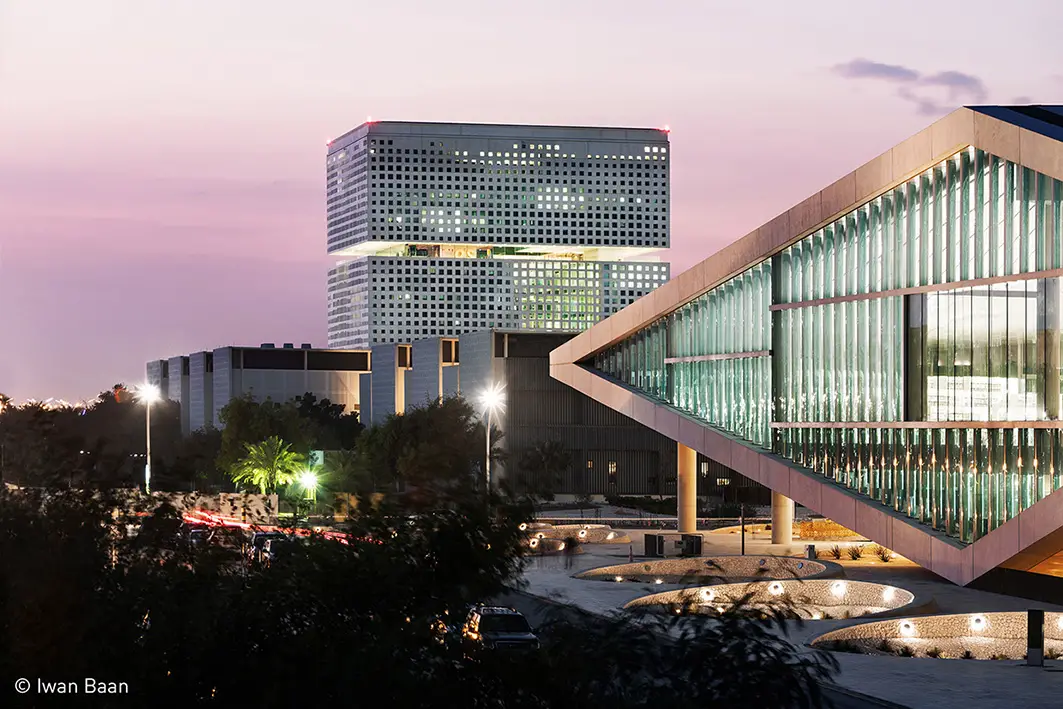CRICURSA Cristales Curvados, SA and Super Spacer® have been a proven team in the production of curved XXL insulating glass units for iconic buildings with unique glass facades for some time now. Especially for energy-efficiency reasons, the warm edge spacer system was also used for the 5,500 square metre glass facade of the Qatar National Library in Doha, which was completed in 2018.
Wave-shape provides stability
Rob Nijsse, Professor of Structural Analysis and former partner of the Dutch engineering company ABT Arnhem, and ABT structural consultant Ronald Wenting were both involved in a leading capacity in the structural design for the first congenial collaboration of Rem Koolhaas and CRICURSA: the Casa da Música concert hall in Porto, the wave-shaped glass facades of which have become something of a trademark of star architect Rem Koolhaas and his Rotterdam office OMA architects over the last 15 years.
In their article “Designing and constructing corrugated glass facades” Rob Njisse and Roland Wenting write: “If the desired corrugated form can be folded from a sheet of paper, then the glass industry will also be able to produce it. ” Indeed, the static benefits of a facade designed as a wave are obvious. In the same way as a sheet of paper that has been folded to form an accordion, it possesses much more rigidity than flat paper. But one should not interpret this quote as nonchalantly as it first sounds. This is because the two structural engineers know from their own experience that there are only a handful of glass bending shops in the world capable of producing curved XXL glass panes in the required qualities, with the necessary tight radii and minimal tolerances.
The planning team also broke new ground with its solution involving the construction of the glass facade as a load-bearing, bracing element. In the case of Porto, Rem Koolhaas had the vision of glass facades without steel and where possible without disruptive pillars, beams, steel cables or frames. A considerable challenge, which was ultimately met by CRICURSA, one of the world’s best renowned manufacturers of curved glass. Curved XXL glass panes arranged in close proximity to each other in a wave-like design, which stabilise each other and thus jointly bear the loads acting upon them, made it possible to dispense with vertical frames.
In the case of Doha the waveform is realised by employing tight radii

The braced corners of the building provide the facade with the exterior shape of a diamond.
Rem Koolhaas also opted for a corrugated glass facade for the recently completed Qatar National Library building for the new Education City in Doha. This time the glass panes are designed in an omega shape, inspired by the notion of drying paper sheets. In a manner resembling the corners of a box being folded up, the glass facades form the shape of a diamond. They filter out the glaring sunlight and illuminate the library with as much diffuse, glare-free daylight as possible. The light is reflected down into the room via a white aluminium ceiling.
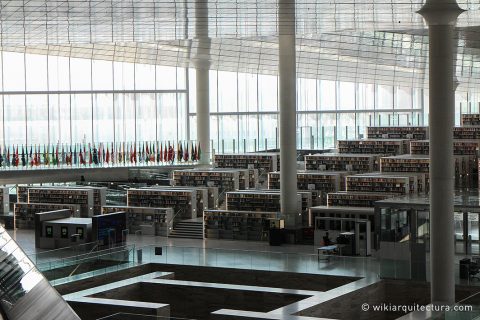
Glass facades provide the room with diffuse, glare-free daylight.
You do not enter the 138-metre long library from the side, but instead access the centre of a single triangular room under the supported corner of the building and you are immediately surrounded by three terraces with marble bookshelves. The Qatar National Library houses more than one million books and 500,000 digital editions across an area of some 42,000 square metres. A mezzanine floor with reading tables, media rooms, study rooms and a large auditorium is accommodated on a self-supporting bridge that spans almost the entire room. OMA architects Rotterdam has come across a particularly spectacular solution for the accommodation of the Heritage Collection, which comprises particularly valuable scriptures and manuscripts on Arab-Islamic civilisation and is presented in the form of a permanent exhibition: a 6-metre deep room with a glass ceiling covered with beige travertine, reminiscent of an excavation labyrinth, was embedded into the ground. The message is clear: Books are treasures that are worth raising in the public’s consciousness.
Facade is energy-optimised
In the Qatar National Library, the absence of metallic elements in the glass facade additionally has a decisive climatic benefit: there are no potential thermal bridges that conduct heat into the interior of the building and which could weaken the insulating effect of the gas layer and warm edge in the curved double glazing. “Qatar is one of the regions most markedly affected by the rise in average temperatures caused by climate change”, explains CRICURSA’s Marketing Director Joan Tarrus. “Outdoors, temperatures exceed 40 degrees centigrade in the summer, the temperature inside the library should be a pleasant 20 degrees. The energy-related and thus production-related challenges placed upon the facade glazing were thus enormous, especially in view of the fact we did not want to plan for mechanical shading under any circumstances.”
The arrangement of the curved glazing ensures the facade is self-supporting and exceptionally resistant to wind loads. “Antoni Gaudí made use of the same principle when he inserted the famous Catenarian arches,” according to Joan Tarrus. Compared to a flat glass surface with an identical pane thickness, the corrugated shape enables much higher loads to be transferred both out of the plane of the glass – the load-bearing capacity increases by 1,000 % here according to Rob Nijsse and Roland Weining – and also in-plane of the glass. In Doha the steel bases between the glass elements were connected with interior columns to provide the construction with even more stability.
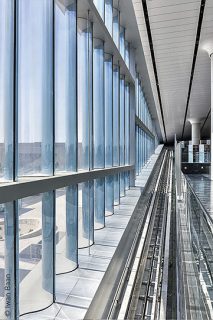
The stacked glass elements are up to 5.50 metres in height.
Joan Tarrus continues: “When we started analysing OMA’s architects new challenge, undulating DGU facade, the new there was only on way: slumping technique. Despite the technical challenges we knew we were going to face due to the extreme climate conditions in Doha, curved annealed glass was the only possible approach to provide an integral solution (geometry, coatings, ceramic frit, dimensions) corrugating the glass to 550 mm radius, providing us with greater freedom in the design process”
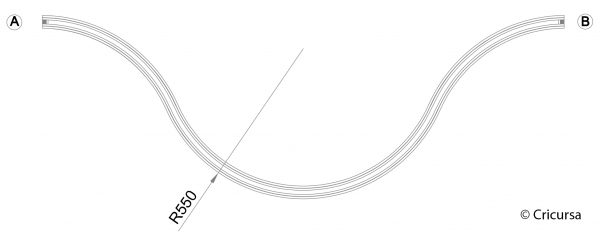
The curved glass panes in the Qatar National Library have a radius of 550 mm.
The glass panes that are up to 5.50 metres high, laminated and curved, are designed as double glazed insulating glass units. A low-e coating, and a solar control coating, filter and reflect sunlight. A grey grid of 3 mm metallic dots with a precise 6 mm spacing between them was burnt into them in order to reduce radiation transmission even further; it represents a technological masterpiece due to these tight radii and the immense sizes involved.
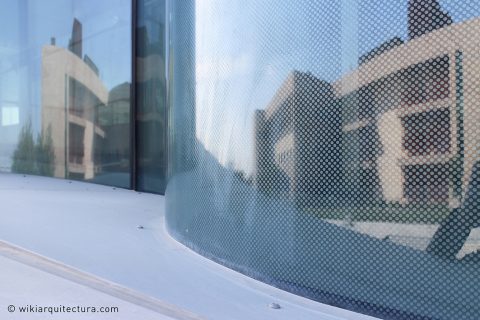
The glass structure is characterised by the filtering and reflection of light and the lowest possible levels of heat input.
Warm Edge indispensable in desert climes
CRICURSA chose the Super Spacer® TriSeal™ Flex product as its warm edge spacer. The product developed by Edgetech/Quanex especially for curved glazing is, based on the experiences of CRICURSA, ideally suited for the extreme climate loads in the desert.
“In this climate region, the use of a warm edge for double glazing is indispensable in order to optimise the energy efficiency of a building,” explains Joachim Stoss, Managing Director of Edgetech Europe GmbH and Vice President International Sales at Quanex. The constant transition between hot sunlight, shade and cooler night temperatures leads to the permanent movement of the glass, and consequently, to considerable mechanical stress on the edge seal. “Flexible spacers such as Super Spacer hermetically seal the space between the panes for many years. Due to the properties of the structural foam the spacer system absorbs the pumping motions of the panes and prevents wear of the primary seal”, explains Joachim Stoss.
About Edgetech Europe GmbH
Edgetech’s Super Spacer® flexible foam-based spacer systems act as energy-efficient
warm edge spacers in insulating glass windows. They significantly reduce energy loss to the outside, largely prevent condensation and also contribute to the lifetime of a window. On average, worldwide, more than 300 million metres are sold annually in over 90 countries.
Edgetech Europe GmbH, located in Heinsberg Germany, is a fully-owned subsidiary of Quanex Building Products Corporation, an industry-leading manufacturer of components sold to Original Equipment Manufacturers (OEMs) in the building products industry. Based in Houston, Texas, Quanex designs and manufactures energy-efficient fenestration products, in addition to kitchen and bath cabinet components. Regarding the turnover Edgetech/Quanex is the world’s largest manufacturer of spacers. Edgetech Europe GmbH is a sales location for the markets in continental Europe and one of the three worldwide Edgetech production plants, with a total of 450 employees and 16 extruders. You can obtain additional information about the Super Spacer® systems and the Warm Edge Technology of Edgetech here: www.superspacer.com.
